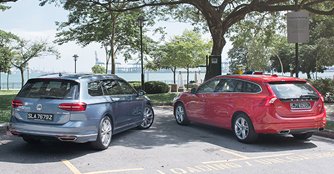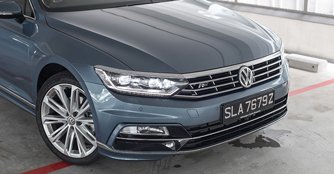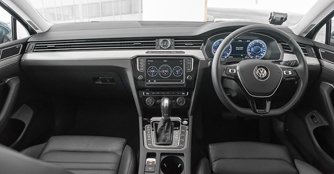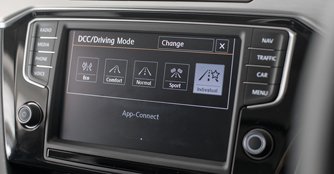Volkswagen Passat Variant 2.0 TSI DSG R-Line vs Volvo V60 T5 Drive-E
01 Jul 2016|21,169 views
Stationwagons or estates haven't gained much popularity in Singapore despite being incredibly practical for families. In the past, one reason why many dodged wagons for sport utility vehicles is the former's lack of style and sporty proposition.
Another reason is the stigma that a wagon resembles a hearse, as many traditional folks claim.
Today, wagons are no longer just an old fart's grocery hauler or boring mum's ride of choice. Take the Audi's RS6 Avant, the Mercedes-Benz CLA-Class Shooting Brake and the Mazda's 6 Wagon for example - the aforesaid cars have proven that a car in estate guise can be more seductive than its sedan counterpart.
One of the sexiest wagons in recent times is undoubtedly the new Volkswagen Passat Variant 2.0 TSI DSG R-Line, and this month, we pit it against the Volvo V60 T5 Drive-E to find out whether the swanky German or punchy Swede is a smarter buy.
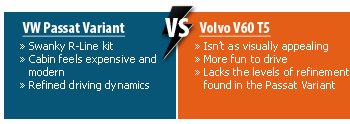 |
Exterior
On the Variant, you get a standard R-Line exterior styling package, striking shoulder lines, wider frontispiece, elongated headlamps and large 19-inch rims, which help deliver a stronger visual presence that its Swedish rival.
Though it's obvious that the Variant is the smarter-looking one of the two, that's not to say that the V60 doesn't have its charms.
Unlike the sharper design of the Wolfsburgian wagon, the V60 runs on 17-inch rims and sports a pudgier, older fashioned image, which should rub Volvo loyalists the right way.
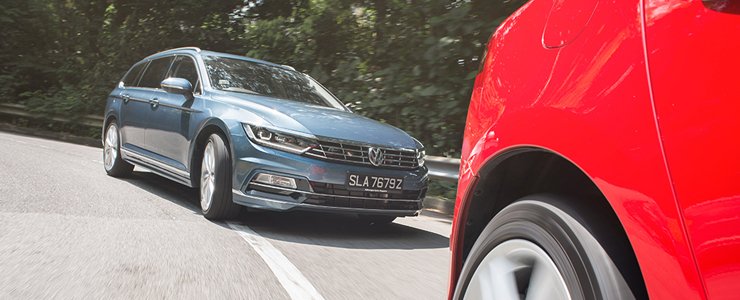 |
Interior
The story is much the same on the inside; the Variant's cabin is a fresher, more modern piece of design work as compared to the V60.
Some of the perks the Variant provides include Volkswagen's new Active Info Display, which increases driving convenience. For example, navigation information can be displayed right smack on the cluster for ease of reference.
Plus, the 'Discover Pro' navigation system comes with App-Connect, which lets you integrate numerous smartphone apps or functions into the infotainment system.
It also triumps in the cargo storage department and backseat space - a generous 650 litre trunk compared to the V60's 430 litres, and noticeably more leg, head and shoulder room.
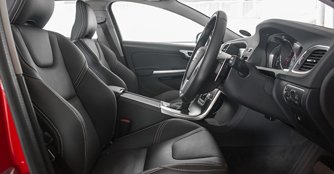
But the V60 hasn't come to the fight without its own bag of party tricks, of which our favourites are - sporty front seats that grip you nice and snug whilst providing an unrivalled level of comfort, nicely-designed flappy-paddle shifters and a neat Adaptive Digital Display.
That said, the V60 is in desperate need of a cabin design update to match the likes of Volkswagen's design language and user-friendliness.
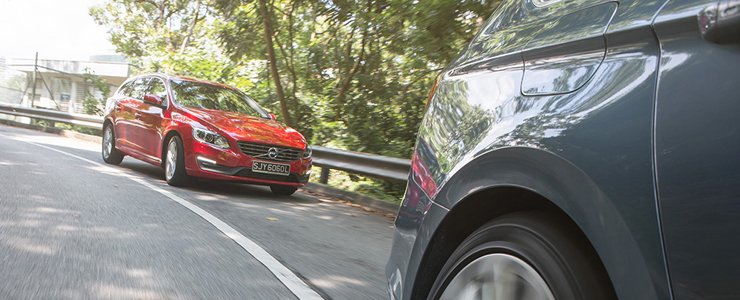 |
The Drive
It is behind the wheel that the Variant begins to lose points to the V60. Let's first study power figures.
The Variant's 2.0-litre four-cylinder TSI motor pushes 217bhp and 350Nm of torque to the front wheels and it's in no way a slow car but the V60's 245bhp and 350Nm of torque give it an advantage over the Variant from the lights.
Because of that 28bhp advantage, the V60 is 0.5 seconds faster from 0-100km/h and its powertrain, too, is livelier and punchier than the Variant.
 | 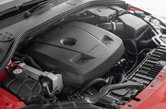 |
Though perhaps, the best part of driving the V60 isn't its dosage of power but its taut dynamics - suspension and chassis is right on point and helm heft too, is welcomingly weighted and more honest on the road.
But to be fair, the Variant's six-speed dual-clutch DSG gearbox is heaps creamier than the V60's eight-speed Geartronic. Manual shifts by means of flap shifters are also slightly quicker in the Variant.
One other thing that the V60 lacks, which is found in the Variant is the Dynamic Chassis Control system that comprises a trio of driving modes - Comfort, Normal and Sport. In Sport, the Variant takes on an agile persona, while Comfort mode makes riding in the car nice and comfortable.
Conclusion
From design to cabin and drive, the Volkswagen Passat Variant 2.0 TSI DSG R-Line is more modern, refined and tech-packed than the Volvo V60 T5 Drive-E.
And, that's largely due to the fact you're paying more for the Variant; $191,800 (as of 24th June 2016) and $185,000 (as of 17th June 2016) for the V60.
But if driving dynamics is an aspect of a car that's on the top of your priority list, the V60's going to be your cup of tea because the Variant is the sort of point-and-squirt machine that tends to get a tad boring down the road.
The V60, although a little rough around the edges, provides a more engaging drive that should please the enthusiast parents.
However, at the end of the day, if we were to pick a wagon that covers most bases, which is going to rip a close-to-$200,000 hole in our pockets, the Variant has our vote.
Stationwagons or estates haven't gained much popularity in Singapore despite being incredibly practical for families. In the past, one reason why many dodged wagons for sport utility vehicles is the former's lack of style and sporty proposition.
Another reason is the stigma that a wagon resembles a hearse, as many traditional folks claim.
Today, wagons are no longer just an old fart's grocery hauler or boring mum's ride of choice. Take the Audi's RS6 Avant, the Mercedes-Benz CLA-Class Shooting Brake and the Mazda's 6 Wagon for example - the aforesaid cars have proven that a car in estate guise can be more seductive than its sedan counterpart.
One of the sexiest wagons in recent times is undoubtedly the new Volkswagen Passat Variant 2.0 TSI DSG R-Line, and this month, we pit it against the Volvo V60 T5 Drive-E to find out whether the swanky German or punchy Swede is a smarter buy.
Exterior
On the Variant, you get a standard R-Line exterior styling package, striking shoulder lines, wider frontispiece, elongated headlamps and large 19-inch rims, which help deliver a stronger visual presence that its Swedish rival.
Though it's obvious that the Variant is the smarter-looking one of the two, that's not to say that the V60 doesn't have its charms.
Unlike the sharper design of the Wolfsburgian wagon, the V60 runs on 17-inch rims and sports a pudgier, older fashioned image, which should rub Volvo loyalists the right way.
On the Variant, you get a standard R-Line exterior styling package, striking shoulder lines, wider frontispiece, elongated headlamps and large 19-inch rims, which help deliver a stronger visual presence that its Swedish rival.
Though it's obvious that the Variant is the smarter-looking one of the two, that's not to say that the V60 doesn't have its charms.
Unlike the sharper design of the Wolfsburgian wagon, the V60 runs on 17-inch rims and sports a pudgier, older fashioned image, which should rub Volvo loyalists the right way.
Interior
The story is much the same on the inside; the Variant's cabin is a fresher, more modern piece of design work as compared to the V60.
Some of the perks the Variant provides include Volkswagen's new Active Info Display, which increases driving convenience. For example, navigation information can be displayed right smack on the cluster for ease of reference.
Plus, the 'Discover Pro' navigation system comes with App-Connect, which lets you integrate numerous smartphone apps or functions into the infotainment system.
The story is much the same on the inside; the Variant's cabin is a fresher, more modern piece of design work as compared to the V60.
Some of the perks the Variant provides include Volkswagen's new Active Info Display, which increases driving convenience. For example, navigation information can be displayed right smack on the cluster for ease of reference.
Plus, the 'Discover Pro' navigation system comes with App-Connect, which lets you integrate numerous smartphone apps or functions into the infotainment system.
It also triumps in the cargo storage department and backseat space - a generous 650 litre trunk compared to the V60's 430 litres, and noticeably more leg, head and shoulder room.
But the V60 hasn't come to the fight without its own bag of party tricks, of which our favourites are - sporty front seats that grip you nice and snug whilst providing an unrivalled level of comfort, nicely-designed flappy-paddle shifters and a neat Adaptive Digital Display.
That said, the V60 is in desperate need of a cabin design update to match the likes of Volkswagen's design language and user-friendliness.
The Drive
It is behind the wheel that the Variant begins to lose points to the V60. Let's first study power figures.
The Variant's 2.0-litre four-cylinder TSI motor pushes 217bhp and 350Nm of torque to the front wheels and it's in no way a slow car but the V60's 245bhp and 350Nm of torque give it an advantage over the Variant from the lights.
Because of that 28bhp advantage, the V60 is 0.5 seconds faster from 0-100km/h and its powertrain, too, is livelier and punchier than the Variant.
Though perhaps, the best part of driving the V60 isn't its dosage of power but its taut dynamics - suspension and chassis is right on point and helm heft too, is welcomingly weighted and more honest on the road.
But to be fair, the Variant's six-speed dual-clutch DSG gearbox is heaps creamier than the V60's eight-speed Geartronic. Manual shifts by means of flap shifters are also slightly quicker in the Variant.
One other thing that the V60 lacks, which is found in the Variant is the Dynamic Chassis Control system that comprises a trio of driving modes - Comfort, Normal and Sport. In Sport, the Variant takes on an agile persona, while Comfort mode makes riding in the car nice and comfortable.
It is behind the wheel that the Variant begins to lose points to the V60. Let's first study power figures.
The Variant's 2.0-litre four-cylinder TSI motor pushes 217bhp and 350Nm of torque to the front wheels and it's in no way a slow car but the V60's 245bhp and 350Nm of torque give it an advantage over the Variant from the lights.
Because of that 28bhp advantage, the V60 is 0.5 seconds faster from 0-100km/h and its powertrain, too, is livelier and punchier than the Variant.
Though perhaps, the best part of driving the V60 isn't its dosage of power but its taut dynamics - suspension and chassis is right on point and helm heft too, is welcomingly weighted and more honest on the road.
But to be fair, the Variant's six-speed dual-clutch DSG gearbox is heaps creamier than the V60's eight-speed Geartronic. Manual shifts by means of flap shifters are also slightly quicker in the Variant.
One other thing that the V60 lacks, which is found in the Variant is the Dynamic Chassis Control system that comprises a trio of driving modes - Comfort, Normal and Sport. In Sport, the Variant takes on an agile persona, while Comfort mode makes riding in the car nice and comfortable.
Conclusion
From design to cabin and drive, the Volkswagen Passat Variant 2.0 TSI DSG R-Line is more modern, refined and tech-packed than the Volvo V60 T5 Drive-E.
And, that's largely due to the fact you're paying more for the Variant; $191,800 (as of 24th June 2016) and $185,000 (as of 17th June 2016) for the V60.
But if driving dynamics is an aspect of a car that's on the top of your priority list, the V60's going to be your cup of tea because the Variant is the sort of point-and-squirt machine that tends to get a tad boring down the road.
The V60, although a little rough around the edges, provides a more engaging drive that should please the enthusiast parents.
However, at the end of the day, if we were to pick a wagon that covers most bases, which is going to rip a close-to-$200,000 hole in our pockets, the Variant has our vote.
Car Information
Volvo V60 T5 Drive-E (A)
CAT B|Petrol|15.6km/L
Horsepower
183kW (245 bhp)
Torque
350 Nm
Acceleration
6.4sec (0-100km /hr)
This model is no longer being sold by local distributor
All Used Volvo V60Volkswagen Passat Variant 2.0 TSI DSG R-Line (A)
CAT B|Petrol|15.4km/L
Horsepower
162kW (217 bhp)
Torque
350 Nm
Acceleration
6.9sec (0-100km /hr)
This model is no longer being sold by local distributor
All Used Volkswagen Passat VariantThank You For Your Subscription.







































